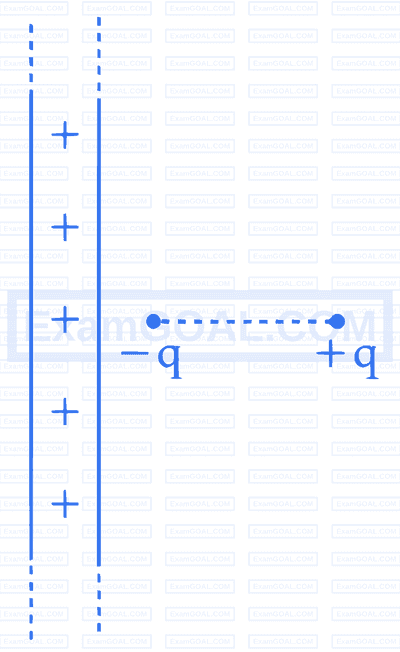
A point charge causes an electric flux of $-2 \times 10^4 \mathrm{Nm}^2 \mathrm{C}^{-1}$ to pass through a spherical Gaussian surface of 8.0 cm radius, centred on the charge. The value of the point charge is :
(Given $\epsilon_0=8.85 \times 10^{-12} \mathrm{C}^2 \mathrm{~N}^{-1} \mathrm{~m}^{-2}$ )

A capacitor, $C_1 = 6 \mu F$ is charged to a potential difference of $V_0 = 5V$ using a 5V battery. The battery is removed and another capacitor, $C_2 = 12 \mu F$ is inserted in place of the battery. When the switch 'S' is closed, the charge flows between the capacitors for some time until equilibrium condition is reached. What are the charges ($q_1$ and $q_2$) on the capacitors $C_1$ and $C_2$ when equilibrium condition is reached.


An electric dipole is placed at a distance of 2 cm from an infinite plane sheet having positive charge density $\sigma_{\mathrm{o}}$. Choose the correct option from the following.


Given below are two statements. One is labelled as Assertion (A) and the other is labelled as Reason (R).
Assertion (A):  Three identical spheres of same mass undergo one dimensional motion as shown in figure with initial velocities $v_{\mathrm{A}}=5 \mathrm{~m} / \mathrm{s}, v_{\mathrm{B}}=2 \mathrm{~m} / \mathrm{s}, v_{\mathrm{C}}=4 \mathrm{~m} / \mathrm{s}$. If we wait sufficiently long for elastic collision to happen, then $v_{\mathrm{A}}=4 \mathrm{~m} / \mathrm{s}, v_{\mathrm{B}}=2 \mathrm{~m} / \mathrm{s}$, $v_{\mathrm{C}}=5 \mathrm{~m} / \mathrm{s}$ will be the final velocities.
Three identical spheres of same mass undergo one dimensional motion as shown in figure with initial velocities $v_{\mathrm{A}}=5 \mathrm{~m} / \mathrm{s}, v_{\mathrm{B}}=2 \mathrm{~m} / \mathrm{s}, v_{\mathrm{C}}=4 \mathrm{~m} / \mathrm{s}$. If we wait sufficiently long for elastic collision to happen, then $v_{\mathrm{A}}=4 \mathrm{~m} / \mathrm{s}, v_{\mathrm{B}}=2 \mathrm{~m} / \mathrm{s}$, $v_{\mathrm{C}}=5 \mathrm{~m} / \mathrm{s}$ will be the final velocities.
Reason (R): In an elastic collision between identical masses, two objects exchange their velocities.
In the light of the above statements, choose the correct answer from the options given below: